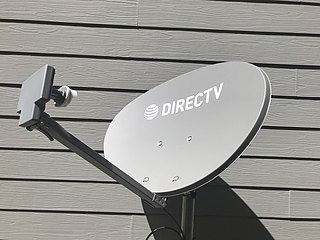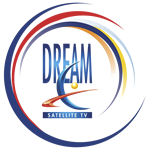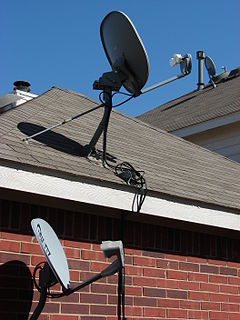Related Research Articles

A communications satellite is an artificial satellite that relays and amplifies radio telecommunication signals via a transponder; it creates a communication channel between a source transmitter and a receiver at different locations on Earth. Communications satellites are used for television, telephone, radio, internet, and military applications. As of 1 August 2020, there are 2,787 artificial satellites in Earth's orbit, with 1,364 of these being communications satellites, used by both private and government organizations. Many are in geostationary orbit 22,236 miles (35,785 km) above the equator, so that the satellite appears stationary at the same point in the sky; therefore the satellite dish antennas of ground stations can be aimed permanently at that spot and do not have to move to track the satellite.
Television receive-only (TVRO) is a term used chiefly in North America to refer to the reception of satellite television from FSS-type satellites, generally on C-band analog; free-to-air and unconnected to a commercial DBS provider. TVRO was the main means of consumer satellite reception in the United States and Canada until the mid-1990s with the arrival of direct-broadcast satellite television services such as PrimeStar, USSB, Bell Satellite TV, DirecTV, Dish Network, Sky TV that transmit Ku signals. While these services are at least theoretically based on open standards, the majority of services are encrypted and require proprietary decoder hardware. TVRO systems relied on feeds being transmitted unencrypted and using open standards, which heavily contrasts to DBS systems in the region.

A satellite dish is a dish-shaped type of parabolic antenna designed to receive or transmit information by radio waves to or from a communication satellite. The term most commonly means a dish which receives direct-broadcast satellite television from a direct broadcast satellite in geostationary orbit.
PrimeStar was a U.S. direct broadcast satellite broadcasting company formed in 1991 by a consortium of cable television system operators and GE Americom, the satellite arm of General Electric, collectively referred to as the PrimeStar Partners. PrimeStar was the first medium-powered DBS system in the United States but slowly declined in popularity with the arrival of DirecTV in 1994 and Dish Network in 1996.

Quincy Media, Inc., formerly known as Quincy Newspapers, Inc., is a family-owned media company that originated in the newspapers of Quincy, Illinois. The company's history can be traced back to 1835, when the Bounty Land Register was one of four newspapers in Illinois. Over the next century, a number of mergers followed. The company moved into radio in 1947 and began television broadcasts in 1953.
Free-to-air (FTA) services are television (TV) and radio services broadcast in clear (unencrypted) form, allowing any person with the appropriate receiving equipment to receive the signal and view or listen to the content without requiring a subscription, other ongoing cost, or one-off fee. In the traditional sense, this is carried on terrestrial radio signals and received with an antenna.

Bell Satellite TV, is the division of BCE Inc. that provides satellite television service across Canada. It launched on September 10, 1997. As of April 2017, Bell Satellite TV provides over 700 channels to over 1 million subscribers. Its major competitors include satellite service Shaw Direct, as well as various cable and communications companies across Canada.
In cable television, governments apply a must-carry regulation stating that locally licensed television stations must be carried on a cable provider's system.
Superstation is a term in North American broadcasting that has several meanings. Commonly, a "superstation" is a form of distant signal, a broadcast television signal—usually a commercially licensed station—that is retransmitted via communications satellite or microwave relay to multichannel television providers over a broad area beyond its primary terrestrial signal range.

WGN America is an American subscription television network that is owned by the Nexstar Media Group, and is the company's only wholly owned, national cable-originated television channel. Nexstar also holds a 31% interest in TV Food Network, LLC, the Discovery, Inc.-controlled parent of Food Network and Cooking Channel. The channel runs a mixture of entertainment programming for most of the broadcast day and a straight-news format—via a daily national prime time newscast, NewsNation—during the evening and early overnight hours.
The concept of television was the work of many individuals in the late 19th and early 20th centuries, with its roots initially starting from back even in the 18th century. The first practical transmissions of moving images over a radio system used mechanical rotating perforated disks to scan a scene into a time-varying signal that could be reconstructed at a receiver back into an approximation of the original image. Development of television was interrupted by the Second World War. After the end of the war, all-electronic methods of scanning and displaying images became standard. Several different standards for addition of color to transmitted images were developed with different regions using technically incompatible signal standards. Television broadcasting expanded rapidly after World War II, becoming an important mass medium for advertising, propaganda, and entertainment.
KNHL, virtual and VHF digital channel 5, is a dual MyNetworkTV/MeTV-affiliated television station licensed to Hastings, Nebraska, United States. As KHAS-TV, it formerly served as the NBC affiliate for the western side of the Lincoln–Hastings–Kearney market. Owned by Gray Television, KNHL is a sister station to Superior-licensed NBC affiliate KSNB-TV ; Lincoln-licensed CBS affiliate KOLN and its satellite KGIN in Grand Island; and Lincoln-licensed CW+ affiliate KCWH-LD. KNHL's transmitter is located on US 281 north of Hastings.
Satellite television is a service that delivers television programming to viewers by relaying it from a communications satellite orbiting the Earth directly to the viewer's location. The signals are received via an outdoor parabolic antenna commonly referred to as a satellite dish and a low-noise block downconverter.

DirecTV is an American direct broadcast satellite service provider based in El Segundo, California, and is a subsidiary of AT&T. Its satellite service, launched on June 17, 1994, transmits digital satellite television and audio to households in the United States, Latin America, and the Caribbean. Its primary competitors are Dish Network, Orby TV, and cable television providers. On July 24, 2015, after receiving approval from the United States Federal Communications Commission and United States Department of Justice, AT&T acquired DirecTV in a transaction valued at $67.1 billion.
Multichannel television in the United States has been available since at least 1948. The United States is served by multichannel television through cable television systems, direct-broadcast satellite providers, and various other wireline video providers; among the largest television providers in the U.S. are AT&T, Altice USA, Charter Communications, Comcast, Dish Network, and Verizon Communications. The Telecommunications Act of 1996 defines a multichannel video programming distributor (MVPD) as "a person such as, but not limited to, a cable operator, a multichannel multipoint distribution service, a direct broadcast satellite service, or a television receive-only satellite program distributor, who makes available for purchase, by subscribers or customers, multiple channels of video programming", where a channel is defined as a "signaling path provided by a cable television system."

Dream Satellite TV was the first all-digital Direct-To-Home (DTH) television broadcasting service via satellite in the Philippines. Broadcasting from the Dream Broadcast Center located at the Clark Special Economic Zone in Pampanga. Content is received from program providers, compressed and broadcast via Koreasat 5 in DVB-S and NTSC color format exclusively to its subscribers using the Integrated Receiver-Decoder and the Conax/Nagravision 3 Encryption System.

Currently, there are three primary satellite television providers of subscription based service available to United States consumers: DirecTV, Dish Network and Orby TV, which have 21 and 10 million subscribers respectively.
All American Direct was an American brand-name consumer-electronics retailer and a distant-network satellite television service provider based in Indianapolis, Indiana. Prior to 2014, the company had an agreement with satellite TV company DISH Network to market and sell DISH Network products, as well as to provide DISH Network customers in remote locations with access to broadcast network programming from distant markets.

Satellite Broadcasting and Communications Association v. FCC, 275 F.3d 337 was a case decided by the United States Court of Appeals for the Fourth Circuit. Congress required satellite television carriers to carry all requesting local broadcast stations in the market where the carrier voluntarily decides to carry one local station in order to, in part, preserve a multiplicity of local broadcast outlets for over-the-air-viewers who do not subscribe either to satellite or cable service.

Locast is an American non-profit streaming television service that allows users to view live streams of over-the-air television stations. These signals are sourced from antennas in each market it serves. Founded by attorney David Goodfriend under the banner of the Sports Fans Coalition, Locast first launched in New York City in January 2018. The service is free, but requires a minimum donation of US$5 per month to view programming without interruption.
References
- ↑ SBCA Member Companies
- ↑ Joseph Widoff (25 March 2011). Savannah Morning News.Missing or empty
|title=(help) - ↑ Satellite TV Group Lauds Defeat Of Proposed Fee
- ↑ SBCA National Standards & Testing Program
- ↑ About SBCA